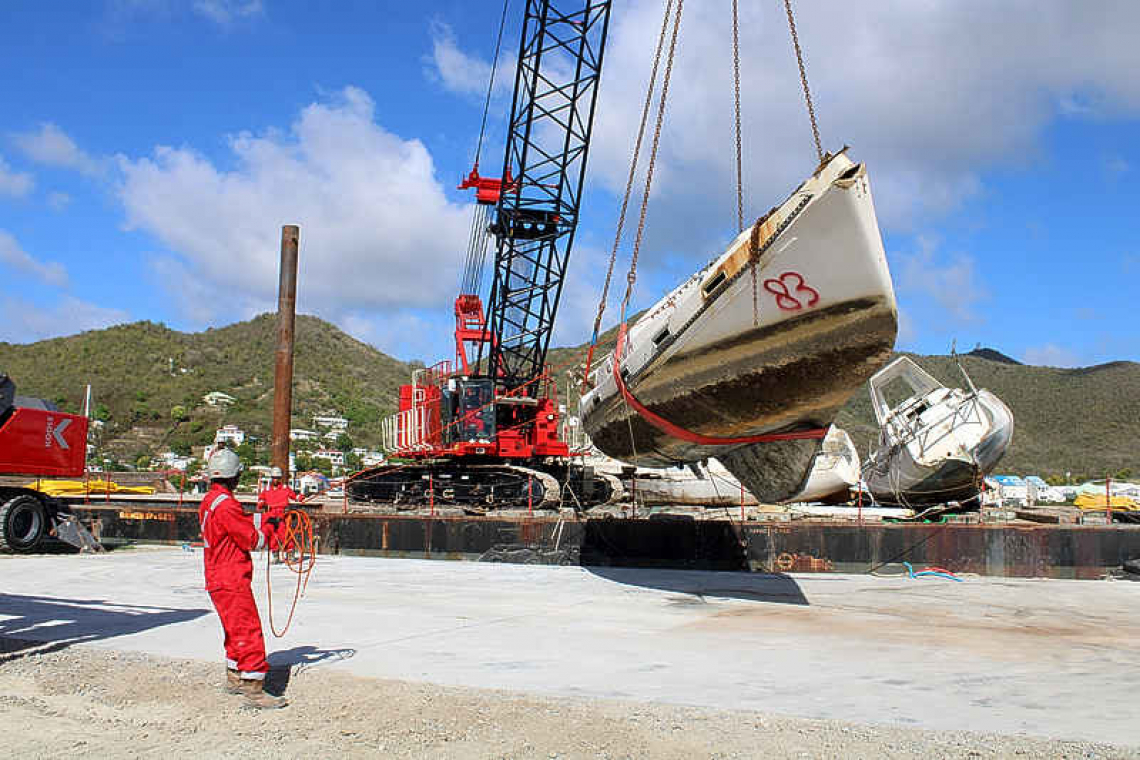Koole employees off-load a boat wreck from the barge in the Geminga boatyard on Monday as the removal operation gets underway. (Robert Luckock photo)
MARIGOT--Koole Contractors launched the long-awaited removal of hurricane-damaged boat wrecks on the French side on Monday with a symbolic crushing of a vessel for elected officials and personnel of environment and natural disaster departments.
Koole is installed at the Geminga boatyard adjacent to the Cadisco gas station in Sandy Ground. It is using the same massive barge and cranes used for the Dutch-side operation that was completed in December 2021. Other equipment on site includes excavators and a shredding machine.
Company owner Paul Koole was present along with Collectivité President Louis Mussington and Vice-President Frantz Gumbs.
Four boat wrecks were removed on Monday as the company gets up to speed. The barge is able to dock at the yard where a crane on board lifts the wrecks and deposits them on a purpose-built concrete apron that prevents any surplus leakage going into the ground.
All toxic waste, oils and fuels are first removed from the wrecks before they are crushed and processed.
“The vessel is sorted into three categories, fibreglass, general debris and wood,” explains Koole supervisor Marc Rooijakkers. “Fibreglass and wood get shredded into two- to-three-inch fragments but not the general debris which is taken away by truck.”
The advantage Koole has on the French side is that the debris from the crushed vessels can be transported to the eco-landfill in Grand Cayes for recycling, which was not the case on the Dutch side where the debris had to be put in containers and shipped to Europe.
Asked about the well-known wreck in Sandy Ground with its bow embedded in a house, Rooijakkers said the schedule for that one to be removed is in two to three weeks.
“That one will have to be cut up by hand. We wouldn’t be able to get close enough with the barge and anyway we are too big to go through the Sandy Ground bridge.”
Mussington was invited to briefly take the controls of an excavator with a scissors attachment to demonstrate how the vessel is broken up.
Koole’s contract is for removal of 140 wrecks, carried out in three stages: 84 wrecks, or parts of, presenting an immediate danger; 41 wrecks presenting a threat of environmental pollution; and 15 abandoned floating wrecks.
However, as Rooijkkers pointed out, according to a survey there are many more wrecks not included in the 140, meaning Koole will be working most likely until December. The Collectivité indicated it will request additional funding from Europe to remove wrecks and shoreline debris not in the original inventory for a complete clean-up.
The current market for the wreck removal is 5,504,500 euros from which 4,231,705 euros comes from European Regional Development Funds (ERDF), 828,637 euros from State credits and 444,157 euros from the Collectivité of St. Martin.
Koole confirmed it will assist the local employment situation and recruit five workers initially. One person has already been employed.
As Paul Koole noted, the company has most of the world covered for salvage operations. It operates in the Caribbean, Curaçao, Suriname, Europe, West Coast of Africa, and most recently in French Polynesia.







